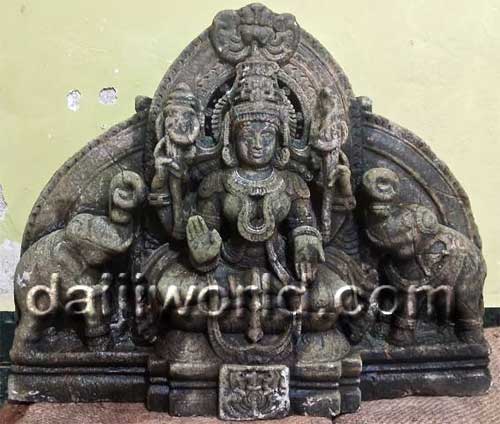Daijiworld Media Network - Udupi
Udupi, Oct 22: A rare and exquisite 10th-century sculpture of Gajalakshmi has been discovered in the Valvanti River at Parye near Sattari Keri in Sattari taluk of Goa — a find that came to light thanks to the initiative of Udupi-based researchers.
The sculpture was first spotted and preserved by Dr Rajendra Kerkar, president of the Adima Kala Trust (R), Udupi. Recognizing its significance, he brought the discovery to the attention of Prof T Murugeshi, archaeologist and founder trustee of the same trust, who later examined and identified the artefact’s historical importance.

According to Prof Murugeshi, the Gajalakshmi figure is seated gracefully on a lotus pedestal, exuding a serene and divine aura. The goddess has four hands — the lower right in Abhaya Mudra, the lower left in Varada Mudra, and the upper pair holding lotus buds. She is adorned with a lower garment, Makarakundalas (ear ornaments), and an elegant three-tiered Karanda Mukuta (crown) under a canopy. An oval-shaped Prabhavali crowned with a lion (Simha Lalata) frames the sculpture, while two elephants holding sacred Kalashas flank her on either side.
A distinctive feature of this sculpture is the intricately carved Gandaberunda — a mythical two-headed bird — in floral form at the pedestal’s center. The sculpture measures about 50 cm in height and 61 cm in width.
Prof Murugeshi identified the sculpture as belonging to the Kadamba period of 10th-century Goa. “This Gajalakshmi represents the artistic brilliance achieved under the Kadambas,” he noted. He also pointed out that while several Gajalakshmi panels have been found across Goa, often depicting tribal or warlike forms, the Parye sculpture is unique for its clear Vaishnava symbolism.
He highlighted that the Gandaberunda motif carved on the pedestal holds special significance, as it served as the royal emblem of the Kadambas, Vijayanagara kings, and Wodeyars of Mysore, and remains the state emblem of Karnataka today.
Prof Murugeshi expressed his appreciation for Dr Rajendra Kerkar and his team for their timely action in safeguarding and facilitating the study of this invaluable heritage find.